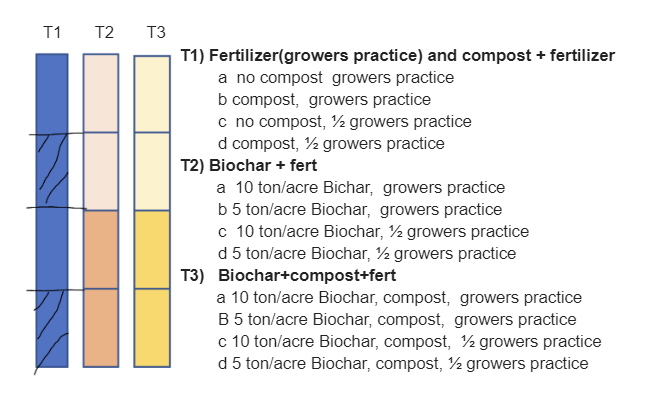Using Biochar to Increase Soil Health and Microbiology
Soil Health Practice Demonstration
at Thrive Farms
Operation Background:
Thrive Hawaii Family Farm is a 2.5-acre certified organic operation in Haleiwa. Both GoFarm Hawaii graduates, Jennifer and Jason Witte lease the land and grow productive food crops like cassava, bok choy, spinach, eggplant, zucchini and other mixed greens and root vegetables. They sell CSA shares locally as well as operate Farm to Barn Cafe on the property, selling breakfast and lunch made with farm produce.
Since beginning their operation, Jennifer and Jason have prioritized rehabilitating their fallow farmland back to health. Soil health practices they have incorporated include soil carbon amendments (compost, biochar, and green mulch), installing windbreaks, rotating crops, and managing irrigation. These practices restore function and health to their soil, and regular soil testing guides their nutrient application.
On a regular basis, Jenn and Jason’s fertilizer program includes prepping all beds with bone meal (tankage) or azomite (volcanic ash). They do another heavy fertilizer application just before planting. They also use a backpack sprayer to apply large batches of kelp extract for nitrogen and KNF sulfur, and occasionally fish emulsion.
Jason and Jenn apply compost every three to six months, which they source from Island Topsoil. They use 2 wheelbarrows full of compost per 100 foot bed. The farmers are happy with the quality of Island Topsoil’s product, which is created following OMRI standards for balanced composting.
For pests, Jenn and Jason spray neem and soap surfactant, and use black plastic to control weeds as needed.
Soil Health Practice:
Through their participation in the Soil Health Cohort Training Program Oahu RC&D launched in partnership with NRCS in March 2022, Thrive Hawai’i Family Farm conducted a trial to integrate biochar into their farm management system to further enhance their soil microbial habitat, continue increasing soil carbon, and potentially enhance water holding capacity.
Soil Health Goals:
“There are a few things I hope to accomplish by using biochar. The first is to increase water retention in the soil, especially during the dry and hot part of the year. The second is to create a more conducive environment in the beds for microbial growth and diversity. I’m really hoping to achieve less water consumption while simultaneously giving a more ideal environment for the soil biome. I believe that if it works well, our produce will cost us less to produce and be of a higher quality. I am also cautiously optimistic that nutrient density of our produce will see some sort of increase as a result of using these practices.”
– Jason Witte
The trial was designed to integrate biochar application as closely as possible into Thrive’s existing operation and its practices.
Three one hundred foot beds were divided up into four sections each, and different combinations of fertilizer (the growers’ existing practice of tankage and azomite), compost, and biochar were implemented (see trial design below).
Amendments were worked in with a BCS harrow and had access to 6 in drip irrigation as needed.

Monitoring and Updates:
Unfortunately, due to unexpected crop issues clear data was not able to be collected from this trial. A second crop trial within a greenhouse was also tried with zucchini, but unfortunately no substantial results were observed.
One important consideration for any farmer applying biochar is that it can take time to improve soil properties and nutrient availability for plants. One application of biochar can last for up to a decade as biochar does not decompose easily (source). Too high applications of biochar may also lead to decline in crop yield due to its large surface area, which allows the nutrients to attach to it and makes them unavailable for plant uptake.
Note: This material is based upon work supported by the U.S. Department of Agriculture, under agreement number NR2192510002C002. Any opinions, findings, conclusions, or recommendations expressed in this publication are those of the author(s) and do not necessarily reflect the views of the U.S. Department of Agriculture. In addition, any reference to specific brands or types of products or services does not constitute or imply an endorsement by the U.S. Department of Agriculture for those products or services.
Resources and References:
- Biochar Application to Leafy Green Varieties on Maui
In this Maui field trial, wood-based biochar application of 10 ton/ha increased the leafy green crops’ fresh weight significantly over the control (no biochar) treatment by 30 and 20% during first and second growing seasons, respectively. - Biochar: A Soil Amendment. Effects on Beans and Other Vegetables
In the Hawaii-based studies outlined in this publication, biochar (made from local macadamia nut husks) was found to have a positive effect on beet and broccoli yields and a negative effect on root-rot nematodes. - Combined application of poultry litter biochar and NPK fertilizer improves cabbage yield and soil chemical properties
This field trial in Ghana found that in field applications of Poultry Litter Biochar (PLB) and NPL fertilizer increased cabbage yields. - Comparative study of poultry litter and poultry litter biochar application in the soil for plant growth
This lab trial in Bangladesh found that 3% application of PLB resulted in significant yield increases for Ipomoea aquatica, a leafy edible vegetable. - Effects of cow dung and wood biochars and green manure on soil fertility and tiger nut performance
This study in Nigeria compared tiger nut growth and yield outcomes from different combinations of green manure (GM), cow dung biochar (CDB), and wood biochar (WB). It finds that a combination of CDB and GM resulted in the highest improvements in growth and yield. Both CDB and WB were less effective on their own than when applied with GM, suggesting that adding a fast releasing nutrient source increases biochar’s ability to increase nutrient availability for plant uptake. - Composting Overview
This extension presentation outlines all the basics about compost: Why it is important, what goes into it, the role of microorganisms, FSMA and NOP standards, different composting forms and systems, and application rates. As a general rule of thumb, for poor soils apply 20 tons per acre, which is 91 lbs of compost per 100 square feet.

